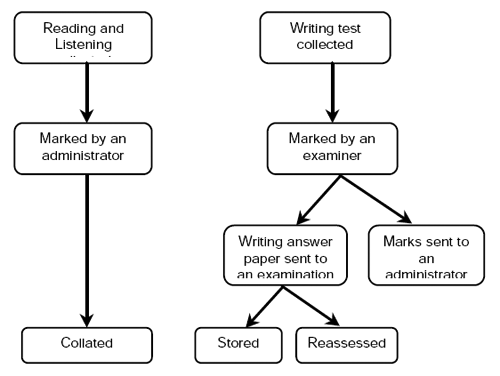Writing task one: processes
You will be given a diagram of a process. Your task is to describe the information given in the diagram by writing a 150 word report. You are not asked to give your opinion.
What is being tested
Task one questions asking you to describe a process rarely appear on the IELTS test. They are different from table, graph and chart description because they test your ability to:
As process tasks can vary widely, it is essential that you look at a lot of examples in IELTS preparation books. You should spend around 20 minutes on the task.
Sample task
You should spend about 20 minutes on this task.
The flow chart below shows how national examination papers are marked in Someland.
Summarise the information by selecting and reporting the main features, and make comparisons where relevant.
Write at least 150 words.

Your task
Complete the Task One report exercise above. Spend only 20 minutes. Then look at the notes and the sample answer below.
Guidelines for a good answer
Does the report have a suitable structure?
Does the report use suitable grammar and vocabulary?
Does the report meet the requirements of the task?
Sample answers
The sample task given is simplified for the sake of explaining this kind of report task clearly. In a genuine test you can expect the process to be more complex.
Sample answer
The flow chart shows the marking procedures for national exam papers in Someland.
After the papers are collected, the Reading and Listening papers are marked by an administrator and then collated. The writing papers are treated differently. After collection, the writing papers are marked by an examiner. The marks are then sent to an administrator for collation while the exam papers are sent to an examination board. The board either stores the papers or reassesses them.
Strategies for improving your IELTS score
Meeting the task requirements
When you begin the writing test, look at the illustration (flow chart, diagram etc) and try to work out what the important stages are, the order they occur and any obvious reasons for the order. Your report must include every stage shown in the diagram or flow chart.
When looking at the illustration, be careful to distinguish stages which happen concurrently. (A is performed at the same time as B) and others which are alternatives (either A or B is performed). The flow chart given in the Sample Task demonstrates this problem. Look at the stages for the writing test. In the second stage we can see that the writing paper is marked by an examiner. It is then sent to the examination board while at the same time the marks are sent to an administrator. These events occur concurrently. In the final stage, the papers are either stored or reassessed. These events are alternatives.
It may happen that the diagram does not make much sense to you at first glance. Look for a starting point and follow through the stages in your mind before beginning to write. If itís still not making sense, then go on to Task Two but make sure that you give yourself 20 minutes to complete the report before the end of the writing test time. It often happens that our brains can sort problems out for us even when we are focusing on something else.
Report structure
Like the line graphs, your report should be structured simply with an introduction, body and conclusion. Tenses should be used appropriately.
Use one standard opening sentence to introduce the report. This opening sentence will make up the first paragraph. You should state simply what the process is. For example:
The flow chart shows the marking procedures for national exam papers in Someland.
Notice that the sample opening sentence does not simply copy the words used in the task instructions. Copied sentences will not be assessed by the examiner and so you waste your time including them.
The body of the report will describe the process in a logical order. A conclusion will generally not be necessary in this kind of report.
Grammar and vocabulary
You will receive a higher mark if your writing uses a range of structures and vocabulary correctly rather than a limited number.
If the flow chart is simple and linear then you may be able to link the stages together by simply using some of the following transition signals:
If the process is more complex, as in the example above, then you may need to also use these words:
Using the present simple passive
The passive is associated with an impersonal formal style. It is often used in notices, announcements and describing processes. Compare the following sentences:
Active: The examiner marks the test paper
Passive: The test paper is marked
The two sentences have the same meaning but the emphasis is different. In the active sentence we are more interested in the person or thing doing the action (the agent).
In the passive sentence we are more interested in the person or thing affected by the action. If we want to mention the agent we use by:
The test paper is marked by the examiner
But often the agent is not important.
The passive is not another way of expressing the same sentence in the active. We choose the active or passive depending on what we are more interested in. In the first sentence we are more interested in the examiner. In the second sentence we are more interested in the test paper.
| Subject | is / are | Past Participle | (by agent) |
|---|---|---|---|
| rapid | is | is | (by the examiner) |